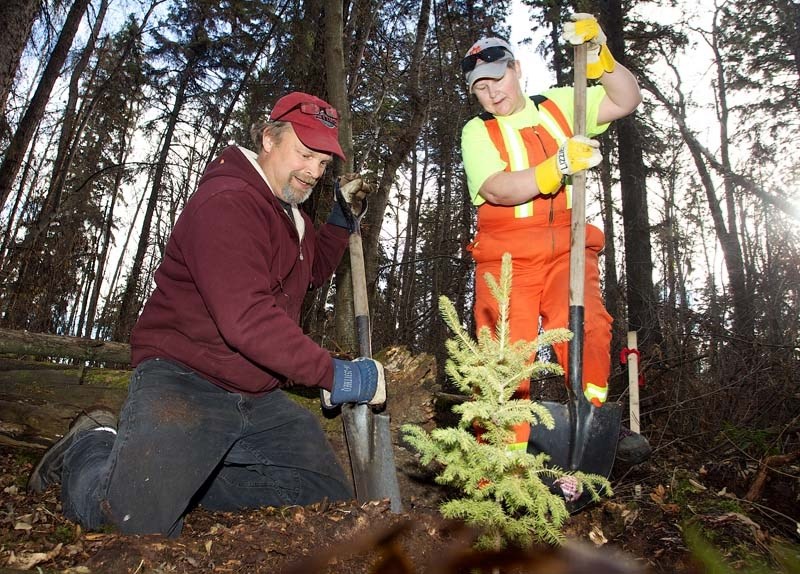A group of city foresters undertook a unique project this week to replant the White Spruce Forest – a task that could take more than 40 years to complete.
A group of city foresters undertook a unique project this week to replant the White Spruce Forest – a task that could take more than 40 years to complete.
Six volunteers with the city’s Grey Nuns White Spruce Park advisory committee planted saplings in two test plots in the white spruce forest west of the grain elevators Wednesday. The plots are part of an experiment to see if human intervention can bring young trees back to the ancient forest.
City arborist Kevin Veenstra pats down some dirt around a just-planted knee-high sapling in one of the plots – a sapling that’s dwarfed by the four-storey titans around it. “It’s going to look great in another 150 years,” he quips.
The white spruce forest is one of the oldest tree stands in St. Albert, says local retired forestry professor Peter Murphy, having been around for the last 150 to 180 years.
But last spring, Murphy discovered that the forest’s days could be numbered. While on a walk through the forest, he noticed that a 25-metre tall spruce had fallen across a path. When he investigated, he found that area off the path where the tree stood was a virtually impenetrable mass of shrubs and brush. “It struck me that there was no young spruce there at all.”
Most of the trees here are already about 130 years old, Murphy says, and some are already blowing down. “The problem is there are no young spruce growing underneath in the openings.” No young trees means an eventual end to the forest.
White spruce trees shed seed all the time, Murphy says, and something was keeping those seeds from sprouting.
The problem looks to be an attack of invasive elderberry plants and mountain ash trees, he says, which have taken over the understory. These plants produce chemicals that make the dirt around them inhospitable to other plants and shade out the ground, both of which may have kept young spruce from taking root.
Core samples and old stumps in the region suggest that this area was partially logged around 1956, Murphy says. That gave elderberry and mountain ash trees from local farms and the old city tree nursery space to invade.
Restoring the forest
“It sounds wrong that we’d have a natural forest and we’d need to manage it,” Murphy admits, but we’ve already influenced this forest by logging. He and the committee now hope to counter this influence with a forest management plan.
With the city manager’s permission, the committee has cleared all the brush in a five-metre radius around two fallen trees in the forest, Veenstra says, and planted 12 white spruce saplings at each spot.
This year’s trees were from a nearby nursery, Murphy says, but the committee hopes to use local spruce seed for future plantings. “There should be a little grove of spruce trees here in another 10 or 20 years.” This first year will be important, he says, as these trees will have to set up a root system.
The team plans to continue clearing brush around these trees for three to four years until the trees are tall enough to grow on their own, Veenstra says. Should this experiment work, the committee hopes to repeat it whenever an old tree in the forest blows down.
The city will likely have to clear brush and replant trees like this for about 40 years before the forest will be self-sustaining once again, Murphy say. Even then, other pressures such as climate change will still press upon it. “This forest pretty soon is going to be on the edge of a very intense urban environment,” he says. “What’ll happen as a result of that, we don’t know.”
Still, he was confident that the forest could be managed. “I think the life of this forest could be extended at least 100 years.”
